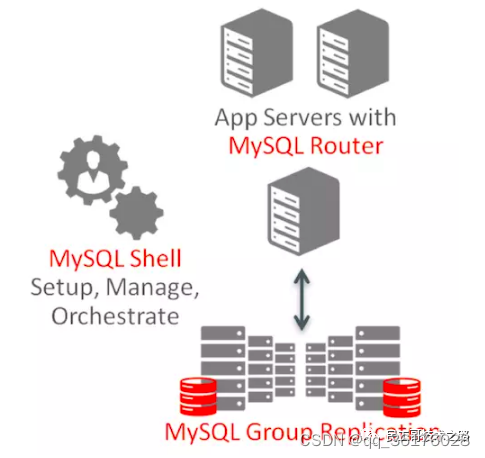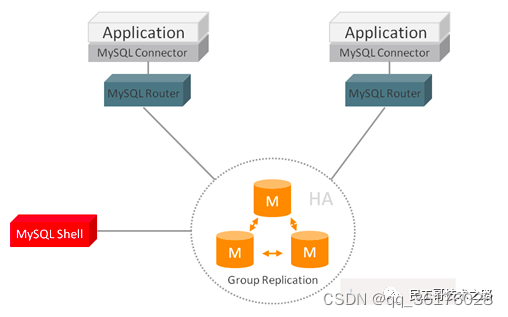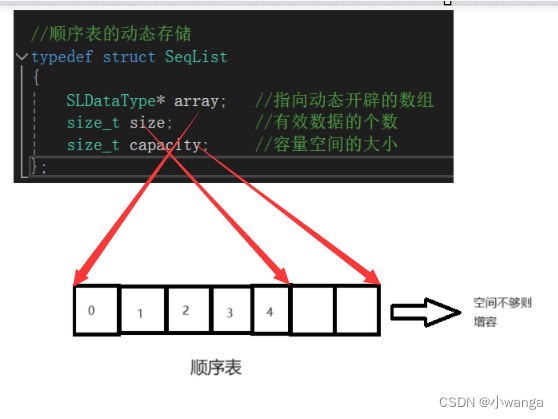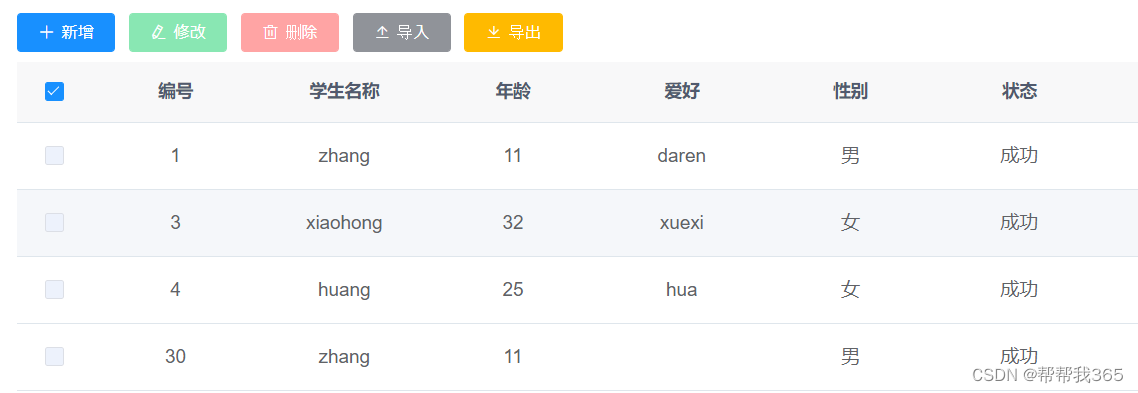今天我将详细的为大家介绍Centos 7.5 基于 MySQL 5.7的 InnoDB Cluster 多节点高可用集群环境部署的相关知识,希望大家能够从中收获多多!如有帮助,请点在看、转发支持一波!!!
一、MySQL InnoDB Cluster 介绍
MySQL的高可用架构无论是社区还是官方,一直在技术上进行探索,这么多年提出了多种解决方案,比如 MMM, MHA, NDB Cluster, Galera Cluster, InnoDB Cluster, 腾讯的PhxSQL, MySQL Fabric., aliSQL。MySQL官方在2017年4月推出了一套完整的、高可用的Mysql解决方案 - MySQL InnoDB Cluster, 即一组MySQL服务器可以配置为一个MySQL集群。在默认的单主节点模式下,集群服务器具有一个读写主节点和多个只读辅节点。辅助服务器是主服务器的副本。客户端应用程序通过MySQL Router连接到主服务程序。如果主服务连接失败,则次要的节点自动提升为主节点,MySQL Router请求到新的主节点。InnoDB Cluster不提供NDB Cluster支持。
1、分布式MySQL之InnoDB和NDB
分布式MySQL主要有InnoDB和NDB模式, NDB是基于集群的引擎-数据被自动切分并复制到数个机器上(数据节点), 适合于那些需要极高查询性能和高可用性的应用, 原来是为爱立信的电信应用设计的。 NDB提供了高达99.999%的可靠性,在读操作多的应用中表现优异。 对于有很多并发写操作的应用, 还是推荐用InnoDB。
========== NDB和InnoDB存储引擎之间的特性差异 ==========
1.1 InnoDB(MySQL 5.7)特性:
-
InnoDB版本:InnoDB 5.7.20;
-
NDB Cluster版本:不支持;
-
大存储长度:64TB;
-
事物:所有标准事物类型;
-
多版本并发控制:支持;
-
数据压缩:支持;
-
大行支:VARBINARY、VARCHAR、BLOB;
-
同步支持:半同步、异步;
-
块读取:支持;
-
块写入:需要使用水平分区;
-
高可用性:高;
1.2 NDB 7.5/7.6特性:
-
InnoDB版本:InnoDB 5.7.20;
-
NDB Cluster版本: NDB 7.5.8/7.6.4;
-
大存储长度:128TB;
-
事物:读提交;
-
多版本并发控制:不支持;
-
数据压缩支持:不支持;
-
大行支持:BLOB、 TEXT;
-
同步支持半:自动同步;
-
块读取:支持;
-
块写入:支持;
-
高可用性:非常高;
二、Mysql InnoDB Cluster 工作原理和流程
MySQL InnoDB集群提供了一个集成的,本地的,HA解决方案。Mysq Innodb Cluster是利用组复制的 pxos 协议,保障数据一致性,组复制支持单主模式和多主模式。
MySQL InnoDB 集群由以下几部分组成:
MySQL Servers with Group Replication:向集群的所有成员复制数据,同时提供容错、自动故障转移和弹性。MySQL Server 5.7.17或更高的版本。
MySQL Router:确保客户端请求是负载平衡的,并在任何数据库故障时路由到正确的服务器。MySQL Router 2.1.3或更高的版本。
MySQL Shell:通过内置的管理API创建及管理Innodb集群。MySQL Shell 1.0.9或更高的版本。
各个组件的关系和工作流程如下:



三、MySQL InnoDB Cluster 集群特性
1、集成易用
MySQL InnoDB集群紧密集成了MySQL Servers with Group Replication,MySQL Router,和MySQL Shell,所以不必依赖于外部工具,脚本或其他部件。 另外它利用了现有的MySQL特性,如:InnoDB, GTIDs, binary logs, multi-threaded slave execution, multi-source replication and Performance Schema。可以在五分钟内利用MySQL Shell中的脚本化的管理API来创建及管理MySQL集群。
2、使用组复制的 mysql server HA
组复制提供了内置的组成员管理、数据一致性保证、冲突检测和处理、节点故障检测和数据库故障转移相关操作的本地高可用性,无需人工干预或自定义工具。组复制同时实现了带自动选主的单主模式及任意更新的多主模式。通过使用一个强大的新的组通信系统,它提供了流行的Paxos算法的内部实现,来自动协调数据复制、一致性、membership。这提供了使MySQL数据库高度可用所需的所有内置机制。
3、弹性
通过组复制,一组服务器协调在一起形成一个组。组成员是动态的,服务器可以自愿或强制的地离开及随时加入。组将根据需要自动重新配置自己,并确保任何加入成员与组同步。这样就可以方便地在需要时快速地调整数据库的总容量。
4、故障检测
组复制实现了一个分布式故障检测器来查找并报告failed或不再参与组的服务器,组中剩余成员将重新配置。
5、容错
组复制基于流行的Paxos分布式算法来提供服务器之间的分布式协调。为了使一个小组继续发挥作用,它要求大多数成员在线,并就每一个变化达成协议。这允许MySQL数据库在发生故障时安全地继续操作,而无需人工干预,不存在数据丢失或数据损坏的风险。
6、自愈
如果一个服务器加入该组,它将自动将其状态与现有成员同步。如果服务器离开该组,例如它被取下来进行维护,剩下的服务器将看到它已离开,并将自动重新配置组。当服务器后重新加入组,它会自动重新与组同步。
7、监测
MySQL Enterprise Monitor 3.4及以后的版本全面支持组复制;监控每个节点的配置,健康,和性能。并且提供佳实践建议和提醒,以及易于理解的可视化工具,允许您轻松地监控和管理您的组复制和InnoDB集群。
8、通过MySQL Router为mysql客户机应用程序实现HA
MySQL的路由器允许您轻松迁移您的独立的MySQL实例到本地分布式高可用集群而不影响现有的应用程序。新metadata_cache插件为Innodb 集群提供了透明的客户端连接路由、负载平衡和故障转移的能力。
9、简单易用的 MySQL shell
MySQL Shell为所有MySQL相关的任务提供了一个直观、灵活、功能强大的接口。 新的adminapi使得它很容易用一种自我描述的自然语言来创建,监控和管理包括MySQL Router在内的MySQL InnoDB集群,而不需要了解低层次的概念,配置选项,或其他复杂的方面。
四、基于 MySQL5.7 的 InnoDB Cluster 高可用部署
下面部署采用InnoDB Cluster, 每台服务器实例都运行MySQL Group Replication (即冗余复制机制,内置failover), MGR有两种模式,一种是Single-Primary,一种是Multi-Primary,即单主或者多主。
需求注意:模式Multi-Primary中,所有的节点都是主节点,都可以同时被读写,看上去这似乎更好,但是因为多主的复杂性,在功能上如果设置了多主模式,则会有一些使用的限制,比如不支持Foreign Keys with Cascading Constraints。
1、环境准备
这里准备了4台centos7版本的服务器用来部署innodb cluster多节点集群环境 (至少也要需要3台服务器), 其中:
db-node01、db-node02、db-node03 作为 cluster 节点服务器, 三个节点都要安装 mysql8.0.x 与 mysql-shell
db-route01 作为管理节点服务器,用来负责创建 cluster,并作为 cluster 的路由, 该节点需要安装mysql-shell、mysql-router
所有节点的python版本要在2.7以上
ip地址 主机名 角色 安装软件
172.16.60.211 db-node01 cluster节点1 Mysql5.7, mysql-shell
172.16.60.212 db-node02 cluster节点2 Mysql5.7, mysql-shell
172.16.60.213 db-node03 cluster节点3 Mysql5.7, mysql-shell
172.16.60.214 db-route01 管理节点1 mysql-shell, mysql-route
[root@db-node01 ~]# cat /etc/redhat-release
CentOS Linux release 7.5.1804 (Core)
[root@db-node01 ~]# python -V
Python 2.7.5为了方便实验,关闭所有节点的防火墙
[root@MGR-node1 ~]# systemctl stop firewalld
[root@MGR-node1 ~]# firewall-cmd --state
not running关闭每个节点的selinux
[root@MGR-node1 ~]# cat /etc/sysconfig/selinux |grep "SELINUX=disabled"
SELINUX=disabled
[root@MGR-node1 ~]# setenforce 0
setenforce: SELinux is disabled
[root@MGR-node1 ~]# getenforce
Disabled配置每个节点的/etc/hosts主机映射, 方便通过节点的hostname进行连接。这一步很重要,否则可能会出现无法同步的情况,因为数据库需要根据member_host同步,如果不配置,默认就是localhost,这样时无法通信的!!!
[root@db-node01 ~]# vim /etc/hosts
...........
172.16.60.211 db-node01
172.16.60.212 db-node02
172.16.60.213 db-node03
172.16.60.214 db-route01所有节点进行如下的相关优化配置
[root@db-node01 ~]# cat>>/etc/sysctl.conf <<EOF
fs.aio-max-nr = 1048576
fs.file-max = 681574400
kernel.shmmax = 137438953472
kernel.shmmni = 4096
kernel.sem = 250 32000 100 200
net.ipv4.ip_local_port_range = 9000 65000
net.core.rmem_default = 262144
net.core.rmem_max = 4194304
net.core.wmem_default = 262144
net.core.wmem_max = 1048586
EOF
[root@db-node01 ~]# sysctl -p
[root@db-node01 ~]# cat>>/etc/security/limits.conf <<EOF
mysql soft nproc 65536
mysql hard nproc 65536
mysql soft nofile 65536
mysql hard nofile 65536
EOF
[root@db-node01 ~]# cat>>/etc/pam.d/login <<EOF
session required /lib/security/pam_limits.so
session required pam_limits.so
EOF
[root@db-node01 ~]# cat>>/etc/profile<<EOF
if [ $USER = "mysql" ]; then
ulimit -u 16384 -n 65536
fi
EOF
[root@db-node01 ~]# source /etc/profilemysql-shell下载地址:https://downloads.mysql.com/archives/get/p/43/file/mysql-shell-1.0.9-linux-glibc2.12-x86-64bit.tar.gz
mysql-route下载地址: https://downloads.mysql.com/archives/get/p/41/file/mysql-router-2.1.4-linux-glibc2.12-x86-64bit.tar.gz
2、在管理节点安装mysql shell 和 mysql-route
[root@db-route01 ~]# cd /usr/local/src/
[root@db-route01 src]# ll
total 21648
-rw-rw-r-- 1 root root 15526654 Mar 8 16:08 mysql-router-2.1.4-linux-glibc2.12-x86-64bit.tar.gz
-rw-rw-r-- 1 root root 6635831 Mar 22 2017 mysql-shell-1.0.9-linux-glibc2.12-x86-64bit.tar.gz
[root@db-route01 src]# tar -zvxf mysql-shell-1.0.9-linux-glibc2.12-x86-64bit.tar.gz
[root@db-route01 src]# tar -zvxf mysql-router-2.1.4-linux-glibc2.12-x86-64bit.tar.gz
[root@db-route01 src]# mv mysql-router-2.1.4-linux-glibc2.12-x86-64bit mysql-route
[root@db-route01 src]# mv mysql-shell-1.0.9-linux-glibc2.12-x86-64bit mysql-shell
[root@db-route01 src]# mv mysql-route /usr/local/
[root@db-route01 src]# mv mysql-shell /usr/local/
[root@db-route01 src]# vim /etc/profile
..............
export PATH=$PATH:/usr/local/mysql-shell/bin/:/usr/local/mysql-route/bin/
[root@db-route01 src]# source /etc/profile
[root@db-route01 ~]# mysqlprovision --version
mysqlprovision version 2.0.0
[root@db-route01 ~]# mysqlsh --version
MySQL Shell Version 1.0.9
[root@db-route01 ~]# mysqlrouter --version
MySQL Router v2.1.4 on Linux (64-bit) (GPL community edition)3、在三个cluster节点安装和部署Mysql5.7及 mysql-shell
3.1、安装mysql-shell (三个节点同样操作)
[root@db-node01 ~]# cd /usr/local/src/
[root@db-node01 src]# ll mysql-shell-1.0.9-linux-glibc2.12-x86-64bit.tar.gz
-rw-r--r-- 1 root root 6635831 Mar 22 2017 mysql-shell-1.0.9-linux-glibc2.12-x86-64bit.tar.gz
[root@db-node01 src]# tar -zvxf mysql-shell-1.0.9-linux-glibc2.12-x86-64bit.tar.gz
[root@db-node01 src]# mv mysql-shell-1.0.9-linux-glibc2.12-x86-64bit mysql-shell
[root@db-node01 src]# mv mysql-shell /usr/local/
[root@db-node01 src]# echo "export PATH=$PATH:/usr/local/mysql-shell/bin/" >> /etc/profile
[root@db-node01 src]# source /etc/profile
[root@db-node01 ~]# mysqlprovision --version
mysqlprovision version 2.0.
[root@db-node01 ~]# mysqlsh --version
MySQL Shell Version 1.0.93.2 安装mysql5.7 (三个节点同样操作)
安装MySQL yum资源库
[root@db-node01 ~]# yum localinstall https://dev.mysql.com/get/mysql57-community-release-el7-8.noarch.rpm安装MySQL 5.7
[root@db-node01 ~]# yum install -y mysql-community-server启动MySQL服务器和MySQL的自动启动
[root@db-node01 ~]# systemctl start mysqld.service
[root@db-node01 ~]# systemctl enable mysqld.service设置登录密码
由于MySQL从5.7开始不允许安装后使用空密码进行登录!为了加强安全性,系统会随机生成一个密码以供管理员登录使用,这个密码记录在/var/log/mysqld.log文件中,使用下面的命令可以查看此密码:
[root@db-node01 ~]# cat /var/log/mysqld.log|grep 'A temporary password'
2019-01-11T05:53:17.824073Z 1 [Note] A temporary password is generated for root@localhost: TaN.k:*Qw2xs使用上面查看的密码TaN.k:*Qw2xs 登录mysql,并重置密码为123456
[root@db-node01 ~]# mysql -p #输入默认的密码:TaN.k:*Qw2xs
.............
mysql> set global validate_password_policy=;
Query OK, rows affected (0.00 sec)
mysql> set global validate_password_length=1;
Query OK, rows affected (0.00 sec)
mysql> set password=password("123456");
Query OK, rows affected, 1 warning (0.00 sec)
mysql> flush privileges;
Query OK, rows affected (0.00 sec)查看mysql版本
[root@db-node01 ~]# mysql -p123456
........
mysql> select version();
+-----------+
| version() |
+-----------+
| 5.7.24 |
+-----------+
1 row in set (0.00 sec)温馨提示:mysql5.7通过上面默认安装后,执行语句可能会报错:
ERROR 1819 (HY00): Your password does not satisfy the current policy requirements这个报错与Mysql 密码安全策略validate_password_policy的值有关,validate_password_policy可以取0、1、2三个值: 解决办法:
set global validate_password_policy=;
set global validate_password_length=1;4、配置my.cnf
先配置db-node01节点的my.cnf
[root@db-node01 ~]# cp /etc/my.cnf /etc/my.cnf.bak
[root@db-node01 ~]# >/etc/my.cnf
[root@db-node01 ~]# vim /etc/my.cnf
[mysqld]
datadir = /var/lib/mysql
socket = /var/lib/mysql/mysql.sock
symbolic-links =
log-error = /var/log/mysqld.log
pid-file = /var/run/mysqld/mysqld.pid
#复制框架
server_id=1
gtid_mode=ON
enforce_gtid_consistency=ON
binlog_checksum=NONE
log_bin=binlog
log_slave_updates=ON
binlog_format=ROW
master_info_repository=TABLE
relay_log_info_repository=TABLE
#组复制设置
#server必须为每个事务收集写集合,并使用XXHASH64哈希算法将其编码为散列
transaction_write_set_extraction=XXHASH64
#告知插件加入或创建组命名,UUID
loose-group_replication_group_name="aaaaaaaa-aaaa-aaaa-aaaa-aaaaaaaaaaaa"
#server启动时不自启组复制,为了避免每次启动自动引导具有相同名称的第二个组,所以设置为OFF。
loose-group_replication_start_on_boot=off
#告诉插件使用IP地址,端口24901用于接收组中其他成员转入连接
loose-group_replication_local_address="172.16.60.211:24901"
#启动组server,种子server,加入组应该连接这些的ip和端口;其他server要加入组得由组成员同意
loose-group_replication_group_seeds="172.16.60.211:24901,172.16.60.212:24901,172.16.60.213:24901"
loose-group_replication_bootstrap_group=off
# 使用MGR的单主模式
loose-group_replication_single_primary_mode = on
disabled_storage_engines = MyISAM,BLACKHOLE,FEDERATED,CSV,ARCHIVE
report_port=3306如上配置完成后, 将db-node01节点的/etc/my.cnf文件拷贝到其他两个节点
[root@db-node01 ~]# rsync -e "ssh -p22" -avpgolr /etc/my.cnf root@172.16.60.212:/etc/
[root@db-node01 ~]# rsync -e "ssh -p22" -avpgolr /etc/my.cnf root@172.16.60.213:/etc/3个cluster节点除了server_id、loose-group_replication_local_address 两个参数不一样外,其他保持一致。
所以待拷贝完成后, 分别修改db-node02和db-node03节点/etc/my.cnf文件的server_id、loose-group_replication_local_address两个参数
配置完成后, 要依次重启三个节点的数据库,安装MGR插件,设置复制账号(所有MGR节点都要执行)
[root@db-node01 ~]# systemctl restart mysqld5、创建Innodb Cluster集群
在 db-node01 上创建集群,通过 db-node01 上的 shell 连接db-node01 的 mysql
[root@db-node01 ~]# mysqlsh
...................
# 执行配置命令,也需要密码
# 然后需要输入MySQL配置文件路径,本示例中的路径是 /usr/local/data/s1/s1.cnf
# 接下来需要创建供其他主机访问的用户,这里选择第1项,为root用户授权
mysql-js> shell.connect('root@localhost:3306');
Please provide the password for 'root@localhost:3306': #输入密码123456
Creating a Session to 'root@localhost:3306'
Classic Session successfully established. No default schema selected.
mysql-js> dba.configureLocalInstance();
Please provide the password for 'root@localhost:3306': #输入密码123456
Detecting the configuration file...
Found configuration file at standard location: /etc/my.cnf
Do you want to modify this file? [Y|n]: #直接回车, 使用默认的/etc/my.cnf配置文件
MySQL user 'root' cannot be verified to have access to other hosts in the network.
1) Create root@% with necessary grants
2) Create account with different name
3) Continue without creating account
4) Cancel
Please select an option [1]: 1 #选择第1项,为root用户授权, 创建供其他主机访问的用户
Password for new account: #输入供其他主机访问的用户root用户授权的密码. 这里依然设置123456
Confirm password:
Validating instance...
Dba.configureLocalInstance: Your password does not satisfy the current policy requirements (MySQL Error 1819)出现上面报错的解决办法:打开另一个终端窗口, 登录db-node01节点的mysql,执行下面命令:
[root@db-node01 ~]# mysql -p123456
.................
mysql> set global validate_password_policy=;
Query OK, rows affected (0.00 sec)
mysql> set global validate_password_length=1;
Query OK, rows affected (0.00 sec)然后接着上面db-node01终端窗口的mysql-shell继续执行:
mysql-js> shell.connect('root@localhost:3306');
Please provide the password for 'root@localhost:3306': #输入密码123456
Creating a Session to 'root@localhost:3306'
Classic Session successfully established. No default schema selected.
mysql-js> dba.configureLocalInstance();
Please provide the password for 'root@localhost:3306': #输入密码123456
Detecting the configuration file...
Found configuration file at standard location: /etc/my.cnf
Do you want to modify this file? [Y|n]: #直接回车, 使用默认的/etc/my.cnf配置文件
MySQL user 'root' cannot be verified to have access to other hosts in the network.
1) Create root@% with necessary grants
2) Create account with different name
3) Continue without creating account
4) Cancel
Please select an option [1]: 1 # 选择第1项,为root用户授权, 即供其他主机访问的用户root用户授权的密码, 否则其他机器使用root用户连接不上不本机的mysql
Password for new account: #输入. 这里依然设置123456. 这里授权之后, 登录db-node01节点的mysql, 执行"select host, user from mysql.user" 命令就能发现
Confirm password:
Validating instance...
The instance 'localhost:3306' is valid for Cluster usage
You can now use it in an InnoDB Cluster.
{
"status": "ok"
}
mysql-js>由上面的信息看出, status 为 ok 说明配置没问题了,可以用来创建cluster。
通过 db-route01 的 mysql-shell 连接 node01 创建 cluster
[root@db-route01 ~]# mysqlsh
................
# 连接db-node01
mysql-js> shell.connect('root@db-node01:3306');
Please provide the password for 'root@db-node01:3306': #输入密码123456
Creating a Session to 'root@db-node01:3306'
Classic Session successfully established. No default schema selected.
# 创建一个 cluster,命名为 'myCluster'
mysql-js> var cluster = dba.createCluster('myCluster');
A new InnoDB cluster will be created on instance 'root@db-node01:3306'.
Creating InnoDB cluster 'myCluster' on 'root@db-node01:3306'...
Adding Seed Instance...
Cluster successfully created. Use Cluster.addInstance() to add MySQL instances.
At least 3 instances are needed for the cluster to be able to withstand up to
one server failure.如上的信息, 如果创建成功, 则会输出的信息中会有类似“Cluster successfully created.”的语句。
#创建成功后,查看cluster状态
mysql-js> cluster.status();
{
"clusterName": "myCluster",
"defaultReplicaSet": {
"name": "default",
"primary": "db-node01:3306",
"status": "OK_NO_TOLERANCE",
"statusText": "Cluster is NOT tolerant to any failures.",
"topology": {
"db-node01:3306": {
"address": "db-node01:3306",
"mode": "R/W",
"readReplicas": {},
"role": "HA",
"status": "ONLINE"
}
}
}
}
mysql-js> dba.getCluster();
<Cluster:myCluster>注意上面这个db-route01的mysql-shell终端窗口就不要关闭了, 一直保持连接中,也就是一直在当前集群状态中, 后面添加其他节点到cluster集群中会用到! (后面说到常用命令时会解释)。
添加节点 db-node02到上面创建的"myCluster"集群中
通过db-node02本机 mysql-shell 对 mysql 进行配置
[root@db-node02 ~]# mysqlsh
................
MySQL JS > shell.connect('root@localhost:3306');
Creating a session to 'root@localhost:3306'
Please provide the password for 'root@localhost:3306': ****** #输入密码123456
Save password for 'root@localhost:3306'? [Y]es/[N]o/Ne[v]er (default No): Y
Fetching schema names for autocompletion... Press ^C to stop.
Your MySQL connection id is 251
Server version: 5.7.25-log MySQL Community Server (GPL)
No default schema selected; type \use <schema> to set one.
<ClassicSession:root@localhost:3306>
MySQL localhost:3306 ssl JS > dba.configureLocalInstance();
Configuring local MySQL instance listening at port 3306 for use in an InnoDB cluster...
This instance reports its own address as 172.16.60.212
WARNING: User 'root' can only connect from localhost.
If you need to manage this instance while connected from other hosts, new account(s) with the proper source address specification must be created.
1) Create remotely usable account for 'root' with same grants and password
2) Create a new admin account for InnoDB cluster with minimal required grants
3) Ignore and continue
4) Cancel
Please select an option [1]: 1
Please provide a source address filter for the account (e.g: 192.168.% or % etc) or leave empty and press Enter to cancel.
Account Host: % #选择%, 表示允许任何机器远程使用root用户连接本机的mysql
The instance 'localhost:3306' is valid for InnoDB cluster usage.
Your password does not satisfy the current policy requirements (MySQL Error 1819)解决办法:登录db-node02节点的mysql
[root@db-node02 ~]# mysql -p123456
...............
mysql> set global validate_password_policy=;
Query OK, rows affected (0.00 sec)
mysql> set global validate_password_length=1;
Query OK, rows affected (0.00 sec)接着继续登录db-node02本机的mysql-shell 进行配置
[root@db-node02 ~]# mysqlsh
.............
MySQL JS > shell.connect('root@localhost:3306');
Creating a session to 'root@localhost:3306'
Fetching schema names for autocompletion... Press ^C to stop.
Your MySQL connection id is 180
Server version: 5.7.25-log MySQL Community Server (GPL)
No default schema selected; type \use <schema> to set one.
<ClassicSession:root@localhost:3306>
MySQL localhost:3306 ssl JS > dba.configureLocalInstance();
Configuring local MySQL instance listening at port 3306 for use in an InnoDB cluster...
This instance reports its own address as db-node02
Clients and other cluster members will communicate with it through this address by default. If this is not correct, the report_host MySQL system variable should be changed.
WARNING: User 'root' can only connect from localhost.
If you need to manage this instance while connected from other hosts, new account(s) with the proper source address specification must be created.
1) Create remotely usable account for 'root' with same grants and password
2) Create a new admin account for InnoDB cluster with minimal required grants
3) Ignore and continue
4) Cancel
Please select an option [1]: 1
Please provide a source address filter for the account (e.g: 192.168.% or % etc) or leave empty and press Enter to cancel.
Account Host: %
The instance 'localhost:3306' is valid for InnoDB cluster usage.
Cluster admin user 'root'@'%' created.
MySQL localhost:3306 ssl JS >然后登录db-node02节点的mysql, 发现上面使用root用户远程连接的授权已经有了
[root@db-node02 ~]# mysql -p123456
..............
mysql> select host,user from mysql.user;
+-----------+---------------+
| host | user |
+-----------+---------------+
| % | root |
| localhost | mysql.session |
| localhost | mysql.sys |
| localhost | root |
+-----------+---------------+
4 rows in set (0.00 sec)接着修改 my.cnf,添加配置项:
[root@db-node02 ~]# vim /etc/my.cnf
............
loose-group_replication_allow_local_disjoint_gtids_join=on重启mysql服务
[root@db-node02 ~]# systemctl restart mysqld然后通过 db-route01节点 的 mysql-shell 添加 node02 到 "myCluster"集群中 接着上面的db-route01的mysql-shell终端窗口 (注意这个终端窗口是上面执行后, 没有关闭一直开着的)
mysql-js> cluster.addInstance('root@db-node02:3306');
A new instance will be added to the InnoDB cluster. Depending on the amount of
data on the cluster this might take from a few seconds to several hours.
Please provide the password for 'root@db-node02:3306':
Adding instance to the cluster ...
The instance 'root@db-node02:3306' was successfully added to the cluster.上面信息表示db-node02节点已经成功添加到"myCluster"集群中了. 如下查看集群状态
mysql-js> cluster.status();
{
"clusterName": "myCluster",
"defaultReplicaSet": {
"name": "default",
"primary": "db-node01:3306",
"status": "OK_NO_TOLERANCE",
"statusText": "Cluster is NOT tolerant to any failures.",
"topology": {
"db-node01:3306": {
"address": "db-node01:3306",
"mode": "R/W",
"readReplicas": {},
"role": "HA",
"status": "ONLINE"
},
"db-node02:3306": {
"address": "db-node02:3306",
"mode": "R/O",
"readReplicas": {},
"role": "HA",
"status": "ONLINE"
}
}
}
}同样, 上面操作后, 这个db-route01节点的mysql-shell当前终端窗口不要关闭,继续保持在集群状态中, 下面添加db-node03节点到集群中会用到这里.(后面常用命令中会提到)
添加节点 db-node03到上面创建的"myCluster"集群中
首先登录db-node03节点的mysql
[root@db-node03 ~]# mysql -p123456
............
mysql> set global validate_password_length=1;
Query OK, rows affected (0.00 sec)
mysql> set global validate_password_length=1;
Query OK, rows affected (0.00 sec)登录db-node03节点的mysql-shell, 进行配置
[root@db-node03 ~]# mysqlsh
.............
MySQL JS > shell.connect('root@localhost:3306');
Creating a session to 'root@localhost:3306'
Please provide the password for 'root@localhost:3306': ******
Save password for 'root@localhost:3306'? [Y]es/[N]o/Ne[v]er (default No): Y
Fetching schema names for autocompletion... Press ^C to stop.
Your MySQL connection id is 393
Server version: 5.7.25-log MySQL Community Server (GPL)
No default schema selected; type \use <schema> to set one.
<ClassicSession:root@localhost:3306>
MySQL localhost:3306 ssl JS > dba.configureLocalInstance();
Configuring local MySQL instance listening at port 3306 for use in an InnoDB cluster...
This instance reports its own address as db-node03
Clients and other cluster members will communicate with it through this address by default. If this is not correct, the report_host MySQL system variable should be changed.
WARNING: User 'root' can only connect from localhost.
If you need to manage this instance while connected from other hosts, new account(s) with the proper source address specification must be created.
1) Create remotely usable account for 'root' with same grants and password
2) Create a new admin account for InnoDB cluster with minimal required grants
3) Ignore and continue
4) Cancel
Please select an option [1]: 1
Please provide a source address filter for the account (e.g: 192.168.% or % etc) or leave empty and press Enter to cancel.
Account Host: %
The instance 'localhost:3306' is valid for InnoDB cluster usage.
Cluster admin user 'root'@'%' created.接着修改 my.cnf,添加配置项:
[root@db-node03 ~]# vim /etc/my.cnf
............
loose-group_replication_allow_local_disjoint_gtids_join=on重启mysql服务
[root@db-node03 ~]# systemctl restart mysqld然后通过 db-route01节点 的 mysql-shell 添加 node03 到 "myCluster"集群中 接着上面的db-route01的mysql-shell终端窗口 (注意这个终端窗口是上面执行后, 没有关闭一直开着的)
mysql-js> cluster.addInstance('root@db-node03:3306');
A new instance will be added to the InnoDB cluster. Depending on the amount of
data on the cluster this might take from a few seconds to several hours.
Please provide the password for 'root@db-node03:3306':
Adding instance to the cluster ...
The instance 'root@db-node03:3306' was successfully added to the cluster.上面信息表示db-node02节点已经成功添加到"myCluster"集群中了. 如下查看集群状态
mysql-js> cluster.status();
{
"clusterName": "myCluster",
"defaultReplicaSet": {
"name": "default",
"primary": "db-node01:3306",
"status": "OK",
"statusText": "Cluster is ONLINE and can tolerate up to ONE failure.",
"topology": {
"db-node01:3306": {
"address": "db-node01:3306",
"mode": "R/W",
"readReplicas": {},
"role": "HA",
"status": "ONLINE"
},
"db-node02:3306": {
"address": "db-node02:3306",
"mode": "R/O",
"readReplicas": {},
"role": "HA",
"status": "ONLINE"
},
"db-node03:3306": {
"address": "db-node03:3306",
"mode": "R/O",
"readReplicas": {},
"role": "HA",
"status": "ONLINE"
}
}
}
}通过上面cluster集群信息可知, db-node01节点是主节点, 具有R/W读写权限, 其他两个节点是从节点, 具有R/O 只读权限
6、启动管理节点的route
进入 db-route01管理节点中mysql-router 安装目录,配置并启动 router
[root@db-route01 ~]# /usr/local/mysql-route/bin/mysqlrouter --bootstrap root@db-node01:3306 -d myrouter --user=root
Please enter MySQL password for root:
Bootstrapping MySQL Router instance at /root/myrouter...
MySQL Router has now been configured for the InnoDB cluster 'myCluster'.
The following connection information can be used to connect to the cluster.
Classic MySQL protocol connections to cluster 'myCluster':
- Read/Write Connections: localhost:6446 #读写端口
- Read/Only Connections: localhost:6447 #只读端口
X protocol connections to cluster 'myCluster':
- Read/Write Connections: localhost:64460
- Read/Only Connections: localhost:64470这里会在当前目录下产生mysql-router 目录, 并生成router配置文件,接着把配置文件修改一下:
[root@db-route01 ~]# ls /root/myrouter/
data log mysqlrouter.conf mysqlrouter.key run start.sh stop.sh
[root@db-route01 ~]# cat /root/myrouter/mysqlrouter.conf #可以修改配置文件, 也可以默认不修改默认通过route连接mysql后, 6446端口连接后可以进行读写操作. 6447端口连接后只能进行只读操作.
然后启动mysqlroute
[root@db-route01 ~]# /root/myrouter/start.sh
PID 16484 written to /root/myrouter/mysqlrouter.pid
[root@db-route01 ~]# ps -ef|grep myroute
root 18473 1 22:26 pts/1 00:00:00 sudo ROUTER_PID=/root/myrouter/mysqlrouter.pid /usr/local/mysql-route/bin/mysqlrouter -c /root/myrouter/mysqlrouter.conf --user=root
root 18486 18473 22:26 pts/1 00:00:00 /usr/local/mysql-route/bin/mysqlrouter -c /root/myrouter/mysqlrouter.conf --user=root
root 18612 5091 22:26 pts/1 00:00:00 grep --color=auto myroute
[root@db-route01 ~]# netstat -tunlp|grep 18486
tcp 0.0.0.0:64460 0.0.0.0:* LISTEN 18486/mysqlrouter
tcp 0.0.0.0:6446 0.0.0.0:* LISTEN 18486/mysqlrouter
tcp 0.0.0.0:6447 0.0.0.0:* LISTEN 18486/mysqlrouter
tcp 0.0.0.0:64470 0.0.0.0:* LISTEN 18486/mysqlroute这样就可以使用MySQL客户端连接router了. 下面验证下连接router:
a) 管理节点本机mysql-shell连接:
[root@db-route01 ~]# mysqlsh --uri root@localhost:6446b) 管理节点本机mysql连接:
[root@db-route01 ~]# mysql -u root -h 127.0.0.1 -P 6446 -pc) 远程客户机通过route连接mysql
[root@db-node01 ~]# mysql -u root -h 172.16.60.214 -P 6446 -p测试cluster节点数据同步. 这里选择db-node03节点作为远程客户端连接router
[root@db-node03 ~]# mysql -u root -h 172.16.60.214 -P 6446 -p
Enter password:
Welcome to the MySQL monitor. Commands end with ; or \g.
Your MySQL connection id is 1054
Server version: 5.7.25-log MySQL Community Server (GPL)
Copyright (c) 2000, 2019, Oracle and/or its affiliates. All rights reserved.
Oracle is a registered trademark of Oracle Corporation and/or its
affiliates. Other names may be trademarks of their respective
owners.
Type 'help;' or '\h' for help. Type '\c' to clear the current input statement.
mysql> show databases;
+-------------------------------+
| Database |
+-------------------------------+
| information_schema |
| mysql |
| mysql_innodb_cluster_metadata |
| performance_schema |
| sys |
+-------------------------------+
5 rows in set (0.00 sec)测试测试库kevin
mysql> CREATE DATABASE kevin CHARACTER SET utf8 COLLATE utf8_general_ci;
ERROR 1044 (42000): Access denied for user 'root'@'%' to database 'kevin'这是因为'root@%'没有创建库的权限
mysql> select host,user from mysql.user;
+-----------+----------------------------------+
| host | user |
+-----------+----------------------------------+
| % | mysql_innodb_cluster_rp496261783 |
| % | mysql_innodb_cluster_rp496457975 |
| % | mysql_innodb_cluster_rp496569258 |
| % | mysql_innodb_cluster_rp496629685 |
| % | mysql_router1_olzau3ltjqzx |
| % | root |
| localhost | mysql.session |
| localhost | mysql.sys |
| localhost | root |
+-----------+----------------------------------+
9 rows in set (.00 sec)
mysql> show grants for root@'%';
+-----------------------------------------------------------------------------------------------------------------------------------------+
| Grants for root@% |
+-----------------------------------------------------------------------------------------------------------------------------------------+
| GRANT RELOAD, SHUTDOWN, PROCESS, FILE, SUPER, REPLICATION SLAVE, REPLICATION CLIENT, CREATE USER ON *.* TO 'root'@'%' WITH GRANT OPTION |
| GRANT SELECT, INSERT, UPDATE, DELETE ON `mysql`.* TO 'root'@'%' WITH GRANT OPTION |
| GRANT SELECT ON `performance_schema`.* TO 'root'@'%' WITH GRANT OPTION |
| GRANT ALL PRIVILEGES ON `mysql_innodb_cluster_metadata`.* TO 'root'@'%' WITH GRANT OPTION |
+-----------------------------------------------------------------------------------------------------------------------------------------+
4 rows in set (.00 sec)登录主库, 创建一个具有管理权权限的用户
[root@db-node01 ~]# mysql -p123456
.............
mysql> set global validate_password_policy=;
Query OK, rows affected (0.00 sec)
mysql> set global validate_password_length=1;
Query OK, rows affected (0.00 sec)
mysql> grant all on *.* to bobo@'%' identified by "bo@123" with grant option;
Query OK, rows affected, 1 warning (0.05 sec)接着远程使用上面创建的新账号登录router操作
[root@db-node03 ~]# mysql -u bobo -h 172.16.60.214 -P 6446 -p
........
mysql> show grants for bobo@'%';
+-------------------------------------------------------------+
| Grants for bobo@% |
+-------------------------------------------------------------+
| GRANT ALL PRIVILEGES ON *.* TO 'bobo'@'%' WITH GRANT OPTION |
+-------------------------------------------------------------+
1 row in set (0.00 sec)测试测试库kevin
mysql> CREATE DATABASE kevin CHARACTER SET utf8 COLLATE utf8_general_ci;
Query OK, 1 row affected (0.06 sec)
mysql> use kevin;
Database changed
mysql> create table if not exists haha (id int(10) PRIMARY KEY AUTO_INCREMENT,name varchar(50) NOT NULL);
Query OK, rows affected (0.22 sec)
mysql> insert into kevin.haha values(1,"wangshibo"),(2,"guohuihui"),(3,"yangyang"),(4,"shikui");
Query OK, 4 rows affected (0.13 sec)
Records: 4 Duplicates: 0 Warnings: 0
mysql> select * from kevin.haha;
+----+-----------+
| id | name |
+----+-----------+
| 1 | wangshibo |
| 2 | guohuihui |
| 3 | yangyang |
| 4 | shikui |
+----+-----------+
4 rows in set (0.00 sec)分别登录三个cluster节点的mysql, 发现测试库kevin已经完成同步了, 其中:写操作的数据会先写到db-node01节点, 然后同步到db-node02和db-node03只读节点上.
注意: 上面使用6446端口连接的route, 可以进行读写操作. 但是使用6447端口连接后, 就只能进行只读操作了. 登录后可以执行" select @@hostname" 查看登录到哪个节点上.
[root@db-node03 ~]# mysql -u bobo -h 172.16.60.214 -P 6447 -p
.............
mysql> select * from kevin.haha;
+----+-----------+
| id | name |
+----+-----------+
| 1 | wangshibo |
| 2 | guohuihui |
| 3 | yangyang |
| 4 | shikui |
+----+-----------+
4 rows in set (0.00 sec)
mysql> delete from kevin.haha where id>2;
ERROR 1290 (HY000): The MySQL server is running with the --super-read-only option so it cannot execute this statement此外, 还可以利用keepalived实现InnoDB Cluster的高可用, 即两台db-route管理节点, 通过VIP资源实现故障无感知切换. 这样需要准备5台节点, 其中3个cluster节点(安装mysql, mysql-shell), 2个route管理节点(安装keepalived, mysql-shell, mysql-route, mysql-client)
五、InnoDB Cluster 集群日常维护命令
在各节点配置之后, 创建cluster集群之前, 可以依次检查下cluster各个节点是否可用
[root@db-node01 ~]# mysqls
.................
mysql-js> dba.checkInstanceConfiguration("root@localhost:3306")
Please provide the password for 'root@localhost:3306':
Validating instance...
The instance 'localhost:3306' is valid for Cluster usage
{
"status": "ok"
}
mysql-js> dba.checkInstanceConfiguration("root@db-node02:3306")
Please provide the password for 'root@db-node02:3306':
Validating instance...
The instance 'db-node02:3306' is valid for Cluster usage
{
"status": "ok"
}
mysql-js> dba.checkInstanceConfiguration("root@db-node03:3306")
Please provide the password for 'root@db-node03:3306':
Validating instance...
The instance 'db-node03:3306' is valid for Cluster usage
{
"status": "ok"
}比如在上面创建Innodb cluster集群过程中, 再次登录mysqlsh (从客户端远程登录, 或任意节点本地登录), 怎么获得并查看集群状态
[root@db-node01 ~]# mysqlsh
.................
mysql-js> shell.connect("root@db-node01:3306");
Please provide the password for 'root@db-node01:3306':
Creating a Session to 'root@db-node01:3306'
Classic Session successfully established. No default schema selected.查看集群状态
mysql-js> cluster.status();
ReferenceError: cluster is not defined上面方式查看, 会报错说集群没有定义, 这时需要先执行下面这条语句之后,才看查看到集群状态!!!!!
mysql-js> cluster.status();
ReferenceError: cluster is not defined然后就可以查看集群状态了
mysql-js> cluster=dba.getCluster();
<Cluster:myCluster>
mysql-js> cluster.status();
{
"clusterName": "myCluster",
"defaultReplicaSet": {
"name": "default",
"primary": "db-node01:3306",
"status": "OK",
"statusText": "Cluster is ONLINE and can tolerate up to ONE failure.",
"topology": {
"db-node01:3306": {
"address": "db-node01:3306",
"mode": "R/W",
"readReplicas": {},
"role": "HA",
"status": "ONLINE"
},
"db-node02:3306": {
"address": "db-node02:3306",
"mode": "R/O",
"readReplicas": {},
"role": "HA",
"status": "ONLINE"
},
"db-node03:3306": {
"address": "db-node03:3306",
"mode": "R/O",
"readReplicas": {},
"role": "HA",
"status": "ONLINE"
}
}
}
}从远程客户端登录
[root@db-node03 ~]# mysqlsh --uri root@172.16.60.214:6446
......................
MySQL 172.16.60.214:6446 ssl JS > cluster=dba.getCluster();
<Cluster:myCluster>
MySQL 172.16.60.214:6446 ssl JS > cluster.status();
{
"clusterName": "myCluster",
"defaultReplicaSet": {
"name": "default",
"primary": "db-node01:3306",
"ssl": "REQUIRED",
"status": "OK",
"statusText": "Cluster is ONLINE and can tolerate up to ONE failure.",
"topology": {
"db-node01:3306": {
"address": "db-node01:3306",
"mode": "R/W",
"readReplicas": {},
"role": "HA",
"status": "ONLINE"
},
"db-node02:3306": {
"address": "db-node02:3306",
"mode": "R/O",
"readReplicas": {},
"role": "HA",
"status": "ONLINE"
},
"db-node03:3306": {
"address": "db-node03:3306",
"mode": "R/O",
"readReplicas": {},
"role": "HA",
"status": "ONLINE"
}
}
},
"groupInformationSourceMember": "mysql://root@172.16.60.214:6446"
}查看已创建的集群名称
MySQL 172.16.60.214:6446 ssl JS > dba.getCluster();
<Cluster:myCluster>六、总结
dba.getCluster(); #查看创建的集群
cluster=dba.getCluster(); #获取当前集群
cluster.status(); #查看集群状态6.1 InnoDB Cluster集群维护的命令帮助
mysql-js> dba.help();
The global variable 'dba' is used to access the MySQL AdminAPI functionality
and perform DBA operations. It is used for managing MySQL InnoDB clusters.
The following properties are currently supported.
- verbose Enables verbose mode on the Dba operations.
The following functions are currently supported.
- checkInstanceConfiguration Validates an instance for usage in Group
Replication.
- configureLocalInstance Validates and configures an instance for
cluster usage.
- createCluster Creates a MySQL InnoDB cluster.
- deleteSandboxInstance Deletes an existing MySQL Server instance on
localhost.
- deploySandboxInstance Creates a new MySQL Server instance on
localhost.
- dropMetadataSchema Drops the Metadata Schema.
- getCluster Retrieves a cluster from the Metadata Store.
- help Provides help about this class and it's
members
- killSandboxInstance Kills a running MySQL Server instance on
localhost.
- rebootClusterFromCompleteOutage Brings a cluster back ONLINE when all
members are OFFLINE.
- resetSession Sets the session object to be used on the
Dba operations.
- startSandboxInstance Starts an existing MySQL Server instance on
localhost.
- stopSandboxInstance Stops a running MySQL Server instance on
localhost.
For more help on a specific function use: dba.help('<functionName>')
e.g. dba.help('deploySandboxInstance')比如获取当前集群名称
mysql-js> dba.getCluster();
<Cluster:myCluster>6.2 日常使用的几个重要命令 (mysqlsh的JS语法)
dba.checkInstanceConfiguration("root@hostname:3306") #检查节点配置实例,用于加入cluster之前
dba.rebootClusterFromCompleteOutage('myCluster'); #重启
dba.dropMetadataSchema(); #删除schema
var cluster = dba.getCluster('myCluster') #获取当前集群
cluster.checkInstanceState("root@hostname:3306") #检查cluster里节点状态
cluster.rejoinInstance("root@hostname:3306") #重新加入节点,我本地测试的时候发现rejoin一直,每次是delete后
addcluster.dissolve({force:true}) #删除集群
cluster.addInstance("root@hostname:3306") #增加节点
cluster.removeInstance("root@hostname:3306") #删除节点
cluster.removeInstance('root@host:3306',{force:true}) #强制删除节点
cluster.dissolve({force:true}) #解散集群
cluster.describe(); #集群描述集群节点状态
- ONLINE: The instance is online and participating in the cluster.
- OFFLINE: The instance has lost connection to the other instances.
- RECOVERING: The instance is attempting to synchronize with the cluster by retrieving transactions it needs before it can become an ONLINE member.
- UNREACHABLE: The instance has lost communication with the cluster.
- ERROR: The instance has encountered an error during the recovery phase or while applying a transaction七、备注:InnoDB Cluster 集群部署中的注意事项
请保证所有的集群机器在一个子网内,网络必须要通, 不然会失败;考虑到可以用桥接的方式实现不同网络之间集群的搭建, 这个并没有亲测;
统一使用hostname进行配置;请更改每台机器的hosts文件;
报错1
ERROR:
Group Replication join failed.
ERROR: Error joining instance to cluster: 'host-192-168-1-101:3306' - Query failed. MySQL Error (3092): The server is not configureroperly to be an active member of the group. Please see more details on error log.. Query: START group_replication
通过如下方式进行处理
mysql> install plugin group_replication soname 'group_replication.so'; ##安装插件
mysql> set global group_replication_allow_local_disjoint_gtids_join=ON;
mysql> START GROUP_REPLICATION;
mysql> select * from performance_schema.replication_group_members;报错2
Dba.getCluster: This function is not available through a session to a standalone instance (RuntimeError)
说明集群中的主节点已经不在该机器上,查询后更改机器重试一下即可;
报错3
Dba.getCluster: Dba.getCluster: Unable to get cluster. The instance 'host-192-168-1-101:3306'
may belong to a different ReplicaSet as the one registered in the Metadata since the value of 'group_replication_group_name'
does not match the one registered in the ReplicaSet's Metadata: possible split-brain scenario. Please connect to another member of the ReplicaSet to get the Cluster. (RuntimeError)
致命的错误,master/slave的数据不一致所致,没办法,只能重新来
mysql-js>dba.dropMetadataSchema();请保证集群中的数据库表都存在主键,不然会挂掉;
安装集群监控,保证集群中机器挂掉的时候及时启动,不然所有节点宕机的时候就是灾难到来之时!!! 到时哭都来不及;
如何重置Innodb cluster集群环境?
主节点:
mysql-js>dba.dropMetadataSchema(); 登录mysql-shell清空集群
mysql> stop group_replication;
mysql> reset master; (清空日志,确保和从库的表没有冲突奥,)
mysql> reset slave;其他节点(主要清理和主库的主从信息, 确保主库和从库的表没有冲突)
mysql> stop group_replication;
mysql> reset master;
mysql> reset slave主机名和 /etc/hosts中名字不一致,出现报错:
[Repl] Slave I/O for channel 'group_replication_recovery': error connecting to master 'mysql_innodb_cluster_r0430970923@mysql3:3306' - retry-time: 60 retries: 1, Error_code: MY-002005
[ERROR] [MY-011582] [Repl] Plugin group_replication reported: 'There was an error when connecting to the donor server. Please check that group_replication_recovery channel credentials and all MEMBER_HOST column values of performance_schema.replication_group_members table are correct and DNS resolvable.'
[ERROR] [MY-011583] [Repl] Plugin group_replication reported: 'For details please check performance_schema.replication_connection_status table and error log messages of Slave I/O for channel group_replication_recovery.'主库的日志应用卡在某个位置无法应用到从库,出现报错:
[ERROR] [MY-010586] [Repl] Error running query, slave SQL thread aborted. Fix the problem, and restart the slave SQL thread with "SLAVE START". We stopped at log 'binlog.000007' position 151
[ERROR] [MY-010584] [Repl] Slave SQL for channel 'group_replication_applier': Error executing row event: 'Unknown database 'mysql_innodb_cluster_metadata'', Error_code: MY-001049重建master:
mysql> stop group_replication;
mysql> reset master;报错 4
[ERROR] Slave SQL for channel 'group_replication_recovery': Could not execute Write_rows event on table mysql_innodb_cluster_metadata.instances;
Cannot add or update a child row: a foreign key constraint fails (mysql_innodb_cluster_metadata.instances, CONSTRAINT instances_ibfk_1 FOREIGN KEY (host_id) REFERENCES hosts (host_id)),
Error_code: 1452; handler error HA_ERR_NO_REFERENCED_ROW; the event's master log binlog.000001, end_log_pos 3059, Error_code: 1452解决方式:清空表mysql_innodb_cluster_metadata.hosts; 重新建立集群
报错5
This member has more executed transactions than those present in the group解决方式:
mysql> stop group_replication;
mysql> reset master;用户操作系统资源的限制
[Warning] Buffered warning: Changed limits: max_open_files: 1024 (requested 5000)
[Warning] Buffered warning: Changed limits: table_open_cache: 431 (requested 2000)解决方式:
# vim /etc/security/limits.conf # 添加下面内容
mysql soft nproc 2047
mysql hard nproc 16384
mysql soft nofile 1024
mysql hard nofile 65535报错 6
dba.rebootClusterFromCompleteOutage: The active session instance isn't the most updated in comparison with the ONLINE instances of the
Cluster's metadata.在集群没有起来时某些机器的数据表发生变动,导致数据不一致;
解决方式:所有MySQL机器通过reset master命令清空binlogs
mysql> reset master;
mysql> show master logs;然后再运行Dba.rebootClusterFromCompleteOutage重启集群。
service mysql restart 无法重启mysql,mysql stuck,并一直输出日志'
[Note] Plugin group_replication reported: '[GCS] cli_err 2''解决方式:停止MySQL的命令为:
#pkill -9 mysqld如何将Multi-Primary改为Single-Primary?
a) 解散原来的集群:mysql-js> cluster.dissolve({force: true})
b) 每台主机MySQL修改如下配置:
mysql> set global group_replication_enforce_update_everywhere_checks=OFF;
mysql> set global group_replication_single_primary_mode=ON;
c) 重新创建集群:
mysql-js> var cluster = dba.createCluster('mysqlCluster');
mysql-js> cluster.addInstance('chianyu@svr2:3306');
mysql-js> cluster.addInstance('chianyu@svr3:3306');组复制的限制
事物锁缺失问题:
组复制建议,事物隔离级别,read commit
序列化隔离级别:多主模式不支持
并发DDL和DML: 多主模式下,不支持 一边对一个表进行DDL,另一边进行更新,这样对于DDL在其他实例上操作有未检出的风险
外键级联约束:多主模式下,多级外键依赖对引起多级操作, 因此可能导致未知冲突,建议打开 group_replication_enforce_update_everywhere_checks=ON
大事物,超过5秒未提交,会导致组通信失败,
多主模式下:select * for update 会导致 死锁。因为这个锁并非全组共享。
部分复制不支持:组复制下,设置部分复制,会过滤事物,导致组事物不一致。
Mysql 8.0.11 group_replication_enforce_update_everywhere_checks=ON 多主模式下不支持。
停止复制的情况下,某个节点执行命令后再启动,会因为本地有私有事物,无法加入集群。需要全局 reset master 重新开始集群复制。
多实例环境不要用 3306端口
多实例环境下,某个实例采用了默认的3306端口,会导致经常性的误操作。一台主机多部署10个实例。比如:
cluster节点A服务器启用三个端口实例: 3310, 3320, 3330,
cluster节点B服务器启用三个端口实例: 3310, 3320, 3330
cluster节点C服务器启用三个端口实例: 3310, 3320, 3330
实例数据目录分别为: /data/mysql3310, /data/mysql3320, /data/mysql3330
管理节点D服务启动三个端口route端口实例: 3310, 3320, 3330
管理节点E服务启动三个端口route端口实例: 3310, 3320, 3330
实例数据目录分别为: /data/router3310, /data/router3320, /data/router3330



















